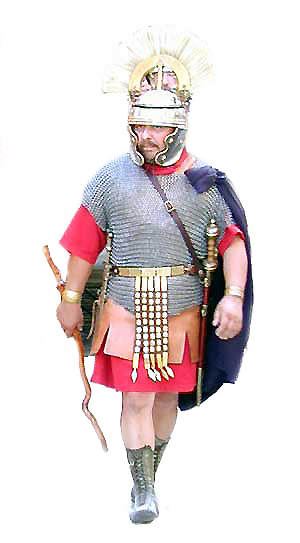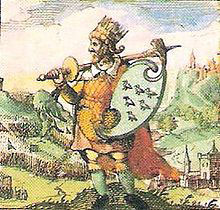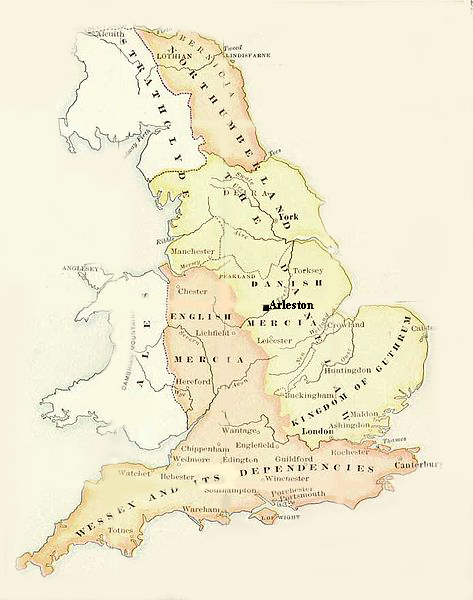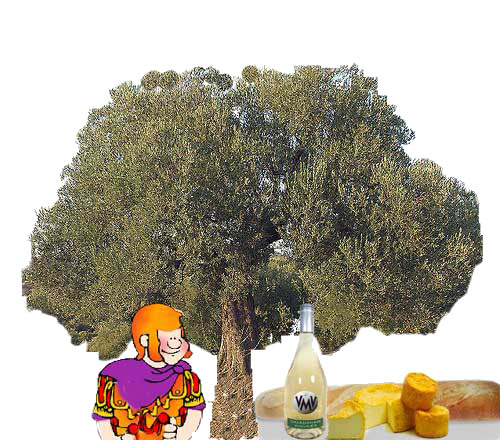|
The
Story of Fabius Maximus.

AD
405
I'm
not really sure if I really wanted to be a soldier but that's
how it turned out. My
father was a soldier in the Roman army and I was born in Rome.
My
parents were delighted at my birth and my father insisted that I
be named after a Roman general.
It was, perhaps, inevitable that the army would be my
life.
So
here I am an Optio with the Roman army based at the far edge of
the Empire in Britannia - not at the very edge of the world
fighting barbarians but
in the centre of the country not far from the abandoned camp at Derventio
My
present posting is a small marching
camp about 5 miles south of the old Fort looking out over a
wide and muddy river that winds its way towards the sea.
It's
not a bad place to be. We've
built a small marching camp for the men and I have a small house
for my family, my wife and my daughter.
The
news from Rome is not good - we seem to have a new Emperor every
few weeks and it feels here as if the Empire is crumbling around
us.
We
got a message yesterday from the camp at Ratae
- the Legion is to return to Rome and there is some urgency to
get across the river before it floods.
I'm
too old to face the thought of 1000 mile march back to the
Imperial city
I've
spoken to my Tesserarius -
Caligula Britannica, and we’ve decided to stay behind
when the legion marches south.
We
like it here.
I've
put together enough money and bought the land here and Caligula
has bought a site just over the hill.
My
land is on the hill - his land is a large area of bog lying
between here and Deventio
Caligula
is an optimist - he believes that he will be able to build a
villa on his land. Twice
now he has sent a petition to the emperor asking for permission
to build and twice the emperor has turned him down.
His
enthusiasm remains and when the legion marches home we shall
remain.
AD
420
Well,
the Legion marched away, they got across the river just
before it started to flood and Caligula and I together with a
couple of others stayed behind as the rearguard.
No
one came back to look for us
The
Centurion, a lazy old man, probably thought we were drowned in
the flood.
The
past few years haven't been too bad, the family has grown up and
there has not been too much trouble from the local tribes.
Poor
old Caligula still hasn't built his villa.
AD
911
Ælle
I
knew I shouldn’t have trusted Caligula with my funeral – he
got something wrong – I don’t know what it was – but I
never saw the River Styx or Charon the boatman, and my spirit
seems condemned to stray forever by the river where I made my
home,
The
past 400 years seem to have passed in a flash – my family grew
up, married and stayed living on the hill overlooking the river,
raised their children managed to survive until the arrival of
the boats
At
first I thought the legions were returning, but the men who
streamed ashore form the boats were wild, fierce warriors intent
of destruction and warfare – none of my male descendants
survived but some of the women and children were captured and
become the families and slave of the invaders
| There
is a small settlement where my old house used to stand
and the leader of the little community is called Ælle.
He is married to my great, great ( I forget how
many greats ) grand-daughter.
They seem to be happy and all things considered
he treats her well.
He claims he is a descendant of Ælle
,King
of the South Saxons, - but nobody really believes
that!
She
tells her children stories of the olden days and
sometimes she tells them about the old, old stories of
the army that marched from the end of world to settle
by the banks of the river
They
call this little settlement the settlement of Ælle
- Ælleiston – though with they speak it
always seems to sound like Arleston
|

|
|

|

A
settlement has grown up near the old fort at Deventio – they
call it Deoraby – and both the Northmen and the original
inhabitants live there but it does cause some problems.
They pay their taxes to the Dane, Guthrum
the Old, and expect the inhabitants of Arleston to do the
same.
The
problem is that the Mercians who live on the other side of the
river demand taxes as well – and no-one knows where the
boundary lies
Things
may change though – Æthelflæd
the daughter of Alfred
King of Wessex is bringing an army and has promised to
capture Deoraby and make it part of Mercia
– some say her brother Edward
may become King of All England
one day
Perhaps
that will solve the boundary problem!!!
There
isn't much point in building at present - if the Danes don't
knock it down the Mercians or men from Wessex
will - and it's less than 50 years since Ivar
the Boneless and the Great
Viking Army over-wintered at Repton
and destroyed everything in sight
AD
1320
The
past 300 years have flown by.
Another invasion - well two really – a final attempt by
the Northmen to invade the North of England was driven off by
the king – Harold
- but he was unable to prevent William
of Normandy invading the country and bringing Norman rule to
all of England
The land here was given to Henry
de Ferrers,
His grandson, Earl
Robert de Ferrers the younger, produced a charter confirming
land grants originally made by Henry de Ferrers to his vassals
including: Alfinus de Breleford, Nigellus de Albiniaco, Robert
fitz Sarle, William de Rolleston, Robert de Dun, Hugh le
Arbalaster, Anscelin de Heginton, Robert de St. Quintin
I remember those charters – the
monks in the Priory across the river made very good copies of
Charters that had been lost or damaged – not always as
accurate, perhaps, as the original!!!
The land Caligula bought and
where he dreamed of building his villa is now called Sedenefeld
which the locals tell me means Big Fen – it’s a marsh –
there is some hunting and the locals have the right to graze the
beasts on the land
It used to belong to a Saxon
thegn named Ulfkell but Henry de Ferrers made it over to William
de Rolleston.
Which is just as well because in
1265 after supporting the wrong side in the Baron's
Revolt the de Ferrers lands were confiscated by the King
The locals keep trying to build
houses – but they keep falling down!
Still the land here now is farmed
by the Knights
Hospitaller, the Sovereign Military Hospitaller Order of St.
John of Jerusalem of Rhodes and of Malta so their Charter must
be good!
AD 1540
It’s been another turbulent
time and the land is in dispute again.
This time the King has taken the land away.
All to do with women and religion
but the Priory across the river has gone, the land of the Priory
and the Knights Hospitaller have been seized and the Court
of Augmentations is selling the land to their cronies and
friends. Who knows
who owns the land now.
It’s still not worth building
anything until times are more settled!
AD 1642 to1646
The country is at war again –
this time a civil
war – the forces of Parliament are ranged against the king
and Sir Anthony Gell has fortified the house at Weston on Trent
and is holding it against the Kings forces who are just across
the river.
About
half a mile east from the village is a large tumulus, which
is said to contain the remains of persons slain in the battle
fought near the place during the civil wars
Time for all sensible men to keep
their heads down!!
AD 1649
The King has lost his head and
the ownership of the land is in dispute again. There has
been quite a lot of very nifty property management going on and
it looks as if Sir Henry Harpur has acquired the land - along
with a great deal more over at Calke Abbey.
AD 1745
It’s time to bar the doors and
close the shutters again.
The advance guard of another army
are making their way across Sinfin Moor.
This time an invading army from Scotland lead by the Young
Pretender has reached Derby and is threatening the peace of
the realm!!
It’s
as far as they got. Sinfin
Moor has had its' 15 minutes of fame
AD 1770
That was the year I got really
excited!
An army of men descended on the
valley.
In no time at all they had dug a
ditch and thrown up a bank on each side of it - I thought the
Legions had returned.
I was wrong!
Instead of building a square marching
fort the ditch and bank just went on and on as if they were
trying to build a rampart across the entire country - and then
they filled it with water!!
They built an artificial river
and for the next 70 years or so boats went up and down the
valley carrying coal and heavy good to who knows where!
Trent
and Mersey Canal
The army was less disciplined
than the Legions - they drank more than Caligula ever did and
the temporary houses that they built disappeared as fast as they
did!
AD 1850
The army came back. This
time no ditch - but it looked as if they were building a Roman
road - it made me proud to watch them.
This time a raised bank, running
as straight as the eye could see - I really felt as if I was
back at home.
But then instead of cobbled stone
they laid strips of iron on the road and carriages pulled by
infernal machines belching smoke and steam ran on the road.
I'm getting to old for all this change!!! Midland
Railway
AD 1857
In 1803 the land was enclosed and
some of the parishioners were granted land as compensation for
the loss of their common rights.
Arleston,
four and a half miles S. by W. from Derby, contains two farm and
six scattered cottage houses, r.
Sinfin, two
and a half miles South. from Derby, contains two farms and two
cottage houses. Sir
J. H. Crewe, Bart., of Calke
Abbey is the sole owner of both properties now. History
of the Harpur Crewe Family
Sinfin
house is a neat residence occupied by Mrs. Eliz. Bancroft, a
farmer, whose family have resided in Barrow
parish upwards of 300 years.
Merrybower,
a quarter-mile South of Arleston was formerly an open common,
and was about 100 years ago noted for a public house upon it,
kept by George Clay, who had a cock-pit here, and was celebrated
as a deer stealer. His house was a noted rendezvous for similar
characters. I’m
sure he is a descendant of Caligula!!
Added October 2011
A
resident of Arleston sent me this scroll - it is so interesting
I have added it to my text
I’ve just stumbled across your blog - fascinating
scriptures and a very welcome insight into the local
‘planning’ issues - you most definitely are not alone.
On the Arleston/Merrybower issue- some flotsam you may or
may not find interesting...
As a
small addition - according to John Radford at Merrybower Farm,
their old inglenook fireplace had two small windows either side
from which people used to sit and watch cock fighting in the
farm yard.
He knows
nothing of the written rumours concerning cock fighting at
Merrybower, nor of George Clay - the farmer living their prior
to him (pre 1960) told of the cock fighting.
The farm
is older than the cottages, which date circa 1800, and with the
stone lintels looks to be of an age that might sit well with
George Clay’s time (mid-late 1700s), the time given by
White’s book.
I have a
short book in a MS Word format, written by a Clay ancestor,
entitled ‘The Clay Family - Part One - From Merrybower, circa
1650 to Piercefield, 1861’ which mentions George and his
ancestors, and makes for some interesting reading.
We’ve also found reference to a ‘Merrybower House’
from records dating back to the mid 17th century - my
mind wonders whether Arleston House was known as that prior to
the hand over to the Harpur estate around the time of the Civil
War - the old owner being kicked out (I assume a royalist), and
the new owners taking a new name for the house.
Either that, or there was another house large enough to be
listed in records as Merrybower House.
Of course, Merrybower House may just be Merrybower Farm,
and George Clay may just have lived there, and may just have sat
in one of those inglenooks watching the fighting.
On another Clay/Merrybower note, a Joseph Clay from
Merrybower and his son, started a brewery in Burton as Joseph
Clay and son, in 1774. Joseph died in 1800 and his son, also
Joseph, took over and delegated the management of the brewery to
his maltster, Thomas Salt.
He later sold out to Thomas Salt and it became Salt’s
Brewery and in turn part of Bass.
To date at Merrybower, we have found various items in the
immediate grounds around the cottages and farm - much 17th,
18th and 19th century pottery, some late
medieval, and a fare few bronze age and older artefacts (flints,
scrapers and suspected hammerstones).
I dearly wish I knew how old the farm was.
Unfortunately, we have found nothing Roman to date, though
as we lie on the main public footpath from Sinfin to Twyford, I
remain hopeful that something may have been dropped. Part of
this footpath may have been down the existing Arleston Lane, as
the west-side hedgerow between Arleston House and the A50 looks
to be ancient hedgerow, according to a friend knowledgeable in
such matters.
I
found a list of the residents in Sinfin and Arleston in 1857
SINFIN
AND ARLESTON TOWNSHIP.
Bancroft
Elizabeth., farmer, Sinfin house
Bancroft Gilbert, farmer
Hague
John, farmer, Moor end
Sale
Richard, jun., farmer,
Wragg William,
farmer
History
of Derbyshire
AD 2010
Not a lot has happened. The land
has been drained, the Trent and Mersey canal linked the East
coast with the West, the railway linked the entire country with
Derby at the heart of the Industrial Revolution and finally a
Trunk Road sliced its’ way along the valley
The town - they call it
Derby now - just gets bigger and bigger - if you walk back
up the hill you can see it creeping slowly over all of the green
fields - I'm not sure that that's a good thing!
And Arleston, -
well Arleston had a population of 31 recorded in the
Domesday Book in 1086
Aelfric; Alric; Amalric; Dunning;
Gamal; Geoffrey Alselin; Godric; Godwine; Gulbert; Ketil;
Kolgrimr; Kolli; Leodmaer; Leofric; Lyfing; Orm; Osmund; Ramkel;
Rawn; Robert; Siward; Theodric; Uhtbrand; Ulf; Ulfkil; William;
Wulfgeat; Wulfsige; Wulfstan; Ylving
And its’ population in 2010 is
32!
Caligula is still trying to get
permission for his villa – the Emperor keeps refusing
The land at Sedenefeld appears to
be owned by Harpur Crewe Limited Liability Company (incorporated
in Delaware, U.S.A.) - but who knows who really owns
the land.
My descendants are spread along
the valley - I know who they are and I keep a benevolent eye on
them even now.
Like me they keep their heads
down, their doors barred and their shutters closed. All
they want is for the world to pass them by.
Nothing Changes
|

|
Living here is not so
bad - all I need is a tree, some bread, some cheese
and some wine!!!!
A
Book of Verses underneath the Bough,
A Jug of Wine, a Loaf of Bread -- and Thou
Beside me singing in the Wilderness --
O, Wilderness were Paradise enow!
from
The Rubaiyyat,
of Omar
Khayyam
|
|